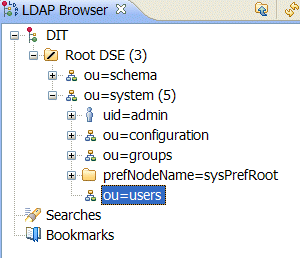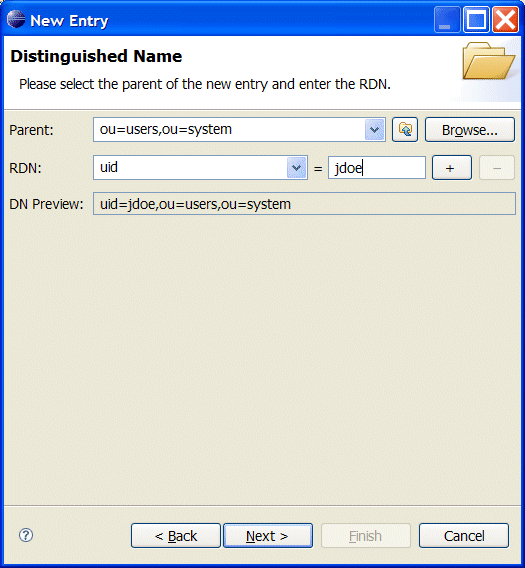Ce contenu n'est pas disponible dans la langue sélectionnée.
8.3. Add User Entries to the Directory Server
Overview
Copier lienLien copié sur presse-papiers!
The basic prerequisite for using LDAP authentication with the OSGi container is to have an X.500 directory server running and configured with a collection of user entries. For many use cases, you will also want to configure a number of groups to manage user roles.
Goals
Copier lienLien copié sur presse-papiers!
In this portion of the tutorial you will
Adding user entries
Copier lienLien copié sur presse-papiers!
Perform the following steps to add user entries to the directory server:
- Ensure that the LDAP server and browser are running.
- In the LDAP Browser view, drill down to the ou=users node.
- Select the ou=users node.
- Open the context menu.
- Select
. The New Entry wizard appears. - In the Entry Creation Method pane, check Create entry from scratch.
- Click Next.The Object Classes pane opens.
- In the Object Classes pane, select
inetOrgPersonfrom the list of Available object classes on the left. - Click Add to populate the list of Selected object classes.
Figure 8.3. New Entry Wizard
- Click .The Distinguished Name pane opens.
- In the the RDN field, enter
uidin front andjdoeafter the equals sign.Figure 8.4. Distinguished Name Step of New Entry Wizard
- Click .The Attributes pane opens.
- Fill in the remaining mandatory attributes in the Attributes pane.
- Set the cn (common name) attribute to
John Doe - Set the sn (surname) attribute to
Doe.
Figure 8.5. Attributes Step of New Entry Wizard
- Add a
userPasswordattribute to the user entry.- Open the context menu in the Attributes pane.
- Select .The New Attribute wizard appears.
- From the Attribute type drop-down list, select .
- Click .The Password Editor dialog appears.
- In the Enter New Password field, enter the password,
secret. - Click OK.The userPassword attribute will appear in the attributes editor.
- Click .
Adding groups for the roles
Copier lienLien copié sur presse-papiers!
To add the groups that define the roles:
- Create a new organizational unit to contain the role groups.
- In the LDAP Browser view, select the ou=system node.
- Open the context menu.
- Select
. The New Entry wizard appears. - In the Entry Creation Method pane, check Create entry from scratch.
- Click Next.The Object Classes pane opens.
- Select
organizationalUnitfrom the list of Available object classes on the left. - Click Add to populate the list of Selected object classes.
- Click .The Distinguished Name pane opens.
- In the the RDN field, enter
ouin front androlesafter the equals sign. - Click .The Attributes pane opens.
- Click .
NoteThis step is required because Apache DS only allows administrators access to entries inou=system,ou=groups. - In the LDAP Browser view, drill down to the ou=roles node.
- Select the ou=roles node.
- Open the context menu.
- Select
. The New Entry wizard appears. - In the Entry Creation Method pane, check Create entry from scratch.
- Click Next.The Object Classes pane opens.
- Select
groupOfNamesfrom the list of Available object classes on the left. - Click Add to populate the list of Selected object classes.
- Click .The Distinguished Name pane opens.
- In the the RDN field, enter
cnin front andadminafter the equals sign. - Click .The Attributes pane opens and you are presented with a DN editor.
- Enter
uid=jdoe. - Click .
- Click .
- In Step 13, use
uid=janedoe. - In Step 13, use
uid=janedoe. - In Step 13, use
uid=crider.



